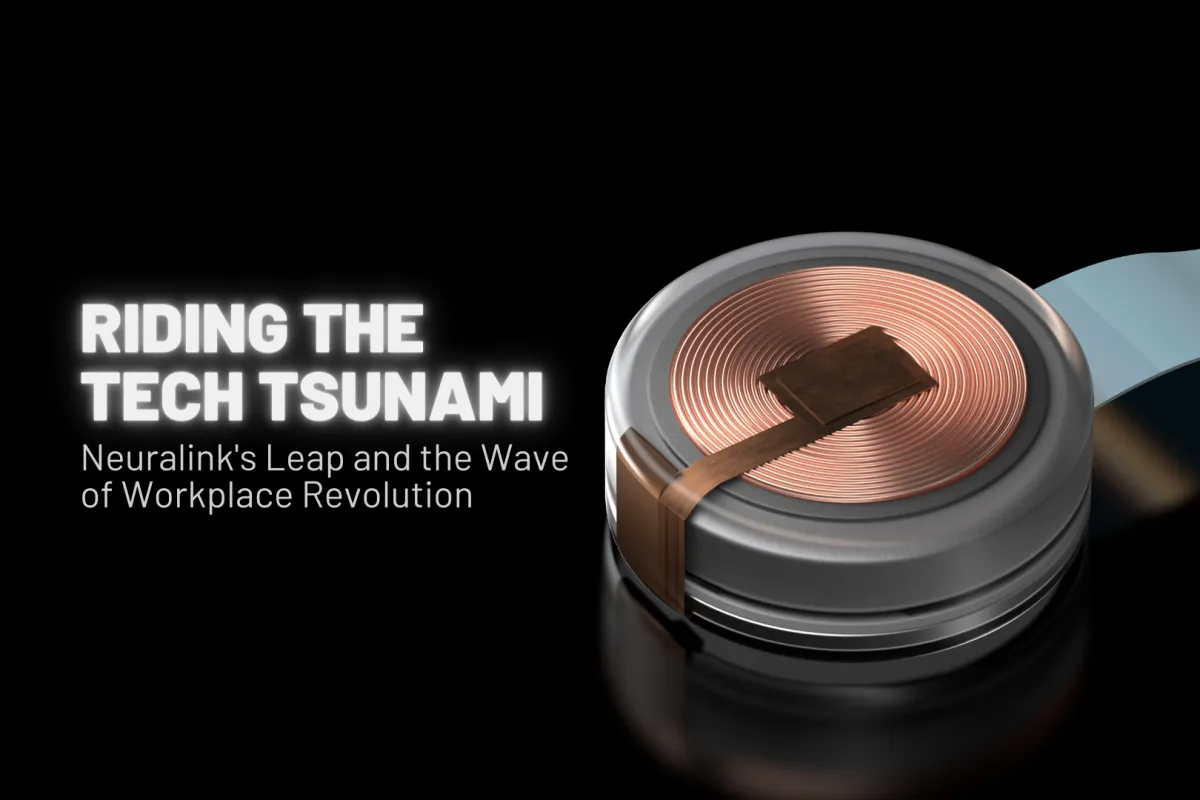Aaron's Blog
Blog Post Categories

Riding the Tech Tsunami: Neuralink's Leap and the Wave of Workplace Revolution 🌊🧠
"Technology is a useful servant but a dangerous master."
- Christian Lous Lange
Introduction
The world of technology is akin to a vast ocean, with waves of innovation constantly crashing upon the shores of business and society. Each wave brings new challenges and opportunities, demanding adaptability and foresight from those who wish to ride its crest. One such monumental wave is the emergence of Neuralink's N1 implant, a groundbreaking innovation that promises to revolutionize our work, especially for those with disabilities.
As business leaders, it's crucial to understand and harness this potential. But why is there such a buzz around this technology? Imagine a world where the barriers of physical disabilities in the workplace are diminished, where communication is not just verbal but can be enhanced through direct brain interfaces. This is not a distant sci-fi dream but a tangible future that Neuralink strives to create.
The pace of technological advancement is relentless. With each passing day, what was once deemed impossible becomes a reality. The N1 implant stands as a testament to this trajectory. We're discussing a minor upgrade and a paradigm shift in human capabilities. This is an era where the lines between man and machine blur, opening up possibilities we once only dreamed of.
But with great potential comes great responsibility. As we stand on the precipice of this new era, it's imperative to approach it with both excitement and caution. Dive in to discover the transformative power of this technology, understand its implications, and discern why, as business leaders and visionaries, it's time to pay attention. The future is unfolding, and the next chapter of human potential is being written. Are you ready to be a part of this narrative?
Background or History
The journey of merging human cognition with machines has been a long-standing aspiration rooted in science and fiction. From ancient myths of gods and mortals endowed with extraordinary powers to modern tales of cyborgs and AI, enhancing human capabilities has always captivated our collective imagination.
The 20th century saw the birth of computers, devices that could process information at speeds unimaginable to the human brain. As these machines evolved, so did our ambition to integrate them more closely with our biological systems. The concept of a brain-computer interface (BCI) was no longer confined to the pages of science fiction; researchers began to explore its real-world applications.
Fast forward to the 21st century, and we find ourselves at an unprecedented juncture. Companies like Neuralink are not just iterating on existing technology but pioneering a new frontier. Founded by visionary entrepreneur Elon Musk, Neuralink's mission transcends the conventional. It's not just about creating a device; it's about forging a new symbiotic relationship between humans and technology.
With its N1 implant, Neuralink aims to bridge the most complex machine known to man – the human brain – with the rapidly evolving world of artificial intelligence. This endeavor is about enhancing human capabilities and addressing some of the most pressing medical challenges, from paralysis to neurodegenerative diseases.
The evolution of this technology is a testament to human ingenuity and perseverance. We've come a long way from rudimentary BCIs that allow simple interactions with computers to sophisticated implants that promise seamless integration. Neuralink stands at the forefront of this journey, heralding a new era in our relationship with technology.
Key Challenges
The promise of Neuralink's N1 implant is undeniably transformative, but with such groundbreaking advancements come a myriad of challenges that society, businesses, and individuals must grapple with.
Ethical Implications: Interfacing the human brain with machines raises ethical questions. Who gets access to these enhancements? Could there be a socio-economic divide, creating a class of 'enhanced' individuals? And how do we ensure the technology isn't misused, leading to potential invasions of privacy or even manipulation of thoughts and emotions?
Integration into the Workplace: The potential enhancement of cognitive abilities presents business challenges. How do traditional work processes adapt to employees with augmented cognitive or communicative abilities? Will there be a divide between those with the implant and those without, and how will teamwork and collaboration be affected?
Medical and Health Concerns: While the N1 implant has undergone rigorous testing, long-term effects on human health remain an area of exploration. How will the body react to such an implant over decades? What are the potential side effects, and how can they be mitigated?
Technological Reliability: As with any technology, reliability and security are challenged. How do we ensure the implant's software is free from vulnerabilities that could be exploited? What safeguards are in place to protect against potential hacking or unauthorized access?
Societal Acceptance: Beyond the practical challenges lies the broader issue of societal acceptance. How will society view individuals with such implants? Will they be seen as pioneers or face skepticism and fear?
In essence, while the N1 implant offers a vision of a future filled with possibilities, it also brings complex challenges that require thoughtful deliberation, collaboration, and careful planning to the fore.
Solutions and Recommendations
In the rapidly evolving landscape of neurotechnology, it's paramount for businesses to adopt a proactive and vigilant stance. The N1 implant, while promising, is still in its early stages, and its widespread application in the workplace remains on the horizon. However, businesses should still be active. On the contrary, now is the time to prepare and strategize.
First and foremost, business leaders should stay informed about the advancements in this field. Regularly attending seminars, webinars, and conferences focused on neurotechnology can provide invaluable insights. Subscribing to journals and publications covering the latest research can keep one abreast of developments.
Engaging with experts in the field is another prudent step. Businesses can better understand brain-machine interfaces' potential implications and challenges by fostering relationships with neuroscientists, ethicists, and technologists. These collaborations can also pave the way for future partnerships when the technology becomes more accessible.
Furthermore, businesses should initiate internal discussions about the potential impact of such technologies. From employees to board members, encouraging stakeholder dialogue can help gauge perceptions, address concerns, and formulate a cohesive strategy.
Lastly, while the mainstream adoption of the N1 implant might be a way off, it's essential to cultivate a culture of adaptability and openness. The future is uncertain, and the thriving businesses will remain agile, ready to harness the opportunities that innovations like Neuralink's N1 implant might bring.
While we await the full realization of the N1 implant's potential, the watchword for businesses is clear: Observe, Engage, and Prepare.
By the Numbers
With Neuralink's N1 implant at its forefront, the realm of neurotechnology is not just a scientific marvel but also a significant economic and societal phenomenon. Here's a deeper dive into the numbers that underscore its potential and the interest it has garnered:
Funding and Investment: Neuralink has secured over $150 million. This substantial financial backing is a testament to the confidence investors have in the potential of this technology. It's not just about the money; it's about the belief in a transformative future.
Clinical Trials: The N1 implant has undergone successful animal trials, a crucial step in biomedical research. The move to human trials marks a significant milestone, bringing the technology closer to mainstream adoption.
Market Potential: The global neurotechnology market, encompassing brain-computer interfaces, neural implants, and more, is expected to reach $19 billion by 2025. This projection indicates the vast economic potential and the growing interest in technologies that bridge the human brain with machines.
Research and Development: Over 200 patents related to brain-computer interfaces have been filed in the last five years alone. This surge in intellectual property showcases the rapid pace of innovation in the field.
Societal Impact: Surveys indicate that 60% of individuals are excited about the potential benefits of brain-computer interfaces, 40% express concerns about privacy and ethical implications. This split underscores the need for transparent communication and ethical considerations as the technology progresses.
Accessibility: Current estimates suggest that initial versions of technologies like the N1 implant could be priced at a premium, potentially limiting early access to affluent individuals or specific medical cases. However, like all technologies, costs are expected to decrease over time, broadening accessibility.
The numbers paint a picture of a field ripe with potential, backed by substantial investment, and poised to shape the future of human-machine interaction.
Future Outlook
As we stand at the cusp of a new era in neurotechnology, the horizon is exciting and filled with uncertainties. The potential of Neuralink's N1 implant and similar innovations promises to reshape not just industries but the very fabric of society.
Medical Breakthroughs: One of the most immediate applications of the N1 implant lies in medicine. From restoring motor functions in paralyzed individuals to offering new communication avenues for those with neurodegenerative diseases, the implant could revolutionize treatments and improve countless lives.
Enhanced Human Potential: Beyond medical applications, there's the tantalizing possibility of enhanced cognitive and communicative abilities. Imagine a world where learning a new language or skill could be expedited or individuals can communicate seamlessly without language barriers.
New Workforce Dynamics: The future workplace might see a blend of individuals with and without neural enhancements. This could lead to new dynamics, challenges, and opportunities in team collaborations, problem-solving, and innovation.
Ethical and Societal Implications: As technology becomes more prevalent, society will grapple with questions of equity, privacy, and identity. Regulations and ethical guidelines will be crucial in ensuring the technology benefits humanity.
Economic Opportunities: The rise of neurotechnology will undoubtedly spawn new industries, job roles, and economic opportunities. From specialists who design and maintain neural interfaces to educators who train individuals to leverage their enhanced capabilities, the economic landscape will see a shift.
Global Collaboration: The implications of brain-machine interfaces are global. Collaborations between countries, industries, and academia will be essential to navigate the challenges and harness the potential of this technology.
In conclusion, the future outlook is a tapestry of challenges and opportunities. As Neuralink and similar ventures progress, they will redefine technological boundaries and challenge us to reimagine what it means to be human.
Conclusion
The journey of technology, from the invention of simple tools to the development of brain-computer interfaces by Neuralink, is a testament to human innovation. The challenges and ethical considerations accompanying such groundbreaking advancements underscore the need for responsible innovation. Business owners and executives must heed the call to action to embrace technology proactively and foster an inclusive and innovative workplace. The insights from "Harness the Juice" guide navigating the technology wave and leveraging it to ensure organizational growth and inclusivity.
Citations
Alfini, Aaron. "Harness the Juice: How to Surf the Impending Tsunami of Technological Innovation without Wiping Out," 2023.
Pierce, David. "Neuralink is recruiting for a human trial of its brain-computer interface," The Verge, September 19, 2023.

Riding the Tech Tsunami: Neuralink's Leap and the Wave of Workplace Revolution 🌊🧠
"Technology is a useful servant but a dangerous master."
- Christian Lous Lange
Introduction
The world of technology is akin to a vast ocean, with waves of innovation constantly crashing upon the shores of business and society. Each wave brings new challenges and opportunities, demanding adaptability and foresight from those who wish to ride its crest. One such monumental wave is the emergence of Neuralink's N1 implant, a groundbreaking innovation that promises to revolutionize our work, especially for those with disabilities.
As business leaders, it's crucial to understand and harness this potential. But why is there such a buzz around this technology? Imagine a world where the barriers of physical disabilities in the workplace are diminished, where communication is not just verbal but can be enhanced through direct brain interfaces. This is not a distant sci-fi dream but a tangible future that Neuralink strives to create.
The pace of technological advancement is relentless. With each passing day, what was once deemed impossible becomes a reality. The N1 implant stands as a testament to this trajectory. We're discussing a minor upgrade and a paradigm shift in human capabilities. This is an era where the lines between man and machine blur, opening up possibilities we once only dreamed of.
But with great potential comes great responsibility. As we stand on the precipice of this new era, it's imperative to approach it with both excitement and caution. Dive in to discover the transformative power of this technology, understand its implications, and discern why, as business leaders and visionaries, it's time to pay attention. The future is unfolding, and the next chapter of human potential is being written. Are you ready to be a part of this narrative?
Background or History
The journey of merging human cognition with machines has been a long-standing aspiration rooted in science and fiction. From ancient myths of gods and mortals endowed with extraordinary powers to modern tales of cyborgs and AI, enhancing human capabilities has always captivated our collective imagination.
The 20th century saw the birth of computers, devices that could process information at speeds unimaginable to the human brain. As these machines evolved, so did our ambition to integrate them more closely with our biological systems. The concept of a brain-computer interface (BCI) was no longer confined to the pages of science fiction; researchers began to explore its real-world applications.
Fast forward to the 21st century, and we find ourselves at an unprecedented juncture. Companies like Neuralink are not just iterating on existing technology but pioneering a new frontier. Founded by visionary entrepreneur Elon Musk, Neuralink's mission transcends the conventional. It's not just about creating a device; it's about forging a new symbiotic relationship between humans and technology.
With its N1 implant, Neuralink aims to bridge the most complex machine known to man – the human brain – with the rapidly evolving world of artificial intelligence. This endeavor is about enhancing human capabilities and addressing some of the most pressing medical challenges, from paralysis to neurodegenerative diseases.
The evolution of this technology is a testament to human ingenuity and perseverance. We've come a long way from rudimentary BCIs that allow simple interactions with computers to sophisticated implants that promise seamless integration. Neuralink stands at the forefront of this journey, heralding a new era in our relationship with technology.
Key Challenges
The promise of Neuralink's N1 implant is undeniably transformative, but with such groundbreaking advancements come a myriad of challenges that society, businesses, and individuals must grapple with.
Ethical Implications: Interfacing the human brain with machines raises ethical questions. Who gets access to these enhancements? Could there be a socio-economic divide, creating a class of 'enhanced' individuals? And how do we ensure the technology isn't misused, leading to potential invasions of privacy or even manipulation of thoughts and emotions?
Integration into the Workplace: The potential enhancement of cognitive abilities presents business challenges. How do traditional work processes adapt to employees with augmented cognitive or communicative abilities? Will there be a divide between those with the implant and those without, and how will teamwork and collaboration be affected?
Medical and Health Concerns: While the N1 implant has undergone rigorous testing, long-term effects on human health remain an area of exploration. How will the body react to such an implant over decades? What are the potential side effects, and how can they be mitigated?
Technological Reliability: As with any technology, reliability and security are challenged. How do we ensure the implant's software is free from vulnerabilities that could be exploited? What safeguards are in place to protect against potential hacking or unauthorized access?
Societal Acceptance: Beyond the practical challenges lies the broader issue of societal acceptance. How will society view individuals with such implants? Will they be seen as pioneers or face skepticism and fear?
In essence, while the N1 implant offers a vision of a future filled with possibilities, it also brings complex challenges that require thoughtful deliberation, collaboration, and careful planning to the fore.
Solutions and Recommendations
In the rapidly evolving landscape of neurotechnology, it's paramount for businesses to adopt a proactive and vigilant stance. The N1 implant, while promising, is still in its early stages, and its widespread application in the workplace remains on the horizon. However, businesses should still be active. On the contrary, now is the time to prepare and strategize.
First and foremost, business leaders should stay informed about the advancements in this field. Regularly attending seminars, webinars, and conferences focused on neurotechnology can provide invaluable insights. Subscribing to journals and publications covering the latest research can keep one abreast of developments.
Engaging with experts in the field is another prudent step. Businesses can better understand brain-machine interfaces' potential implications and challenges by fostering relationships with neuroscientists, ethicists, and technologists. These collaborations can also pave the way for future partnerships when the technology becomes more accessible.
Furthermore, businesses should initiate internal discussions about the potential impact of such technologies. From employees to board members, encouraging stakeholder dialogue can help gauge perceptions, address concerns, and formulate a cohesive strategy.
Lastly, while the mainstream adoption of the N1 implant might be a way off, it's essential to cultivate a culture of adaptability and openness. The future is uncertain, and the thriving businesses will remain agile, ready to harness the opportunities that innovations like Neuralink's N1 implant might bring.
While we await the full realization of the N1 implant's potential, the watchword for businesses is clear: Observe, Engage, and Prepare.
By the Numbers
With Neuralink's N1 implant at its forefront, the realm of neurotechnology is not just a scientific marvel but also a significant economic and societal phenomenon. Here's a deeper dive into the numbers that underscore its potential and the interest it has garnered:
Funding and Investment: Neuralink has secured over $150 million. This substantial financial backing is a testament to the confidence investors have in the potential of this technology. It's not just about the money; it's about the belief in a transformative future.
Clinical Trials: The N1 implant has undergone successful animal trials, a crucial step in biomedical research. The move to human trials marks a significant milestone, bringing the technology closer to mainstream adoption.
Market Potential: The global neurotechnology market, encompassing brain-computer interfaces, neural implants, and more, is expected to reach $19 billion by 2025. This projection indicates the vast economic potential and the growing interest in technologies that bridge the human brain with machines.
Research and Development: Over 200 patents related to brain-computer interfaces have been filed in the last five years alone. This surge in intellectual property showcases the rapid pace of innovation in the field.
Societal Impact: Surveys indicate that 60% of individuals are excited about the potential benefits of brain-computer interfaces, 40% express concerns about privacy and ethical implications. This split underscores the need for transparent communication and ethical considerations as the technology progresses.
Accessibility: Current estimates suggest that initial versions of technologies like the N1 implant could be priced at a premium, potentially limiting early access to affluent individuals or specific medical cases. However, like all technologies, costs are expected to decrease over time, broadening accessibility.
The numbers paint a picture of a field ripe with potential, backed by substantial investment, and poised to shape the future of human-machine interaction.
Future Outlook
As we stand at the cusp of a new era in neurotechnology, the horizon is exciting and filled with uncertainties. The potential of Neuralink's N1 implant and similar innovations promises to reshape not just industries but the very fabric of society.
Medical Breakthroughs: One of the most immediate applications of the N1 implant lies in medicine. From restoring motor functions in paralyzed individuals to offering new communication avenues for those with neurodegenerative diseases, the implant could revolutionize treatments and improve countless lives.
Enhanced Human Potential: Beyond medical applications, there's the tantalizing possibility of enhanced cognitive and communicative abilities. Imagine a world where learning a new language or skill could be expedited or individuals can communicate seamlessly without language barriers.
New Workforce Dynamics: The future workplace might see a blend of individuals with and without neural enhancements. This could lead to new dynamics, challenges, and opportunities in team collaborations, problem-solving, and innovation.
Ethical and Societal Implications: As technology becomes more prevalent, society will grapple with questions of equity, privacy, and identity. Regulations and ethical guidelines will be crucial in ensuring the technology benefits humanity.
Economic Opportunities: The rise of neurotechnology will undoubtedly spawn new industries, job roles, and economic opportunities. From specialists who design and maintain neural interfaces to educators who train individuals to leverage their enhanced capabilities, the economic landscape will see a shift.
Global Collaboration: The implications of brain-machine interfaces are global. Collaborations between countries, industries, and academia will be essential to navigate the challenges and harness the potential of this technology.
In conclusion, the future outlook is a tapestry of challenges and opportunities. As Neuralink and similar ventures progress, they will redefine technological boundaries and challenge us to reimagine what it means to be human.
Conclusion
The journey of technology, from the invention of simple tools to the development of brain-computer interfaces by Neuralink, is a testament to human innovation. The challenges and ethical considerations accompanying such groundbreaking advancements underscore the need for responsible innovation. Business owners and executives must heed the call to action to embrace technology proactively and foster an inclusive and innovative workplace. The insights from "Harness the Juice" guide navigating the technology wave and leveraging it to ensure organizational growth and inclusivity.
Citations
Alfini, Aaron. "Harness the Juice: How to Surf the Impending Tsunami of Technological Innovation without Wiping Out," 2023.
Pierce, David. "Neuralink is recruiting for a human trial of its brain-computer interface," The Verge, September 19, 2023.
Copyright 2025. All rights reserved
Testimonials

Lorem ipsum dolor sit amet, consectetur adipiscing elit, sed do eiusmod tempor incididunt ut labore et dolore magna aliqua. Ut enim ad minim veniam, quis nostrud exercitation ullamco laboris nisi ut aliquip ex ea commodo consequat.
JANE DOE

Lorem ipsum dolor sit amet, consectetur adipiscing elit, sed do eiusmod tempor incididunt ut labore et dolore magna aliqua. Ut enim ad minim veniam, quis nostrud exercitation ullamco laboris nisi ut aliquip ex ea commodo consequat.

